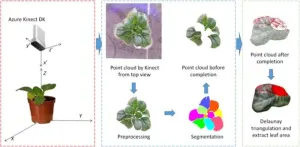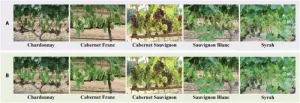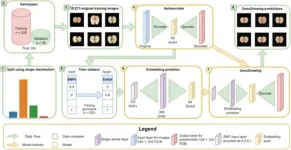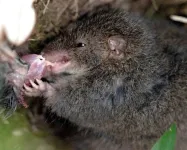(Press-News.org)
The 3-dimensional point cloud technology revolutionizes non-invasive measurement of plant phenotypic parameters, offering vital data for agriculture and research. Current research focuses on overcoming the limitations of 2.5D imaging and occlusions. Methods such as structure from motion, multi-view stereo, and advanced active 3D reconstruction techniques are being explored for this purpose. However, issues persist with incomplete data acquisition and the inaccuracy of phenotypic parameter extraction due to plant occlusions and environmental factors. Recently, integrating deep learning with point cloud analysis and innovative techniques like Reinforcement Learning Agent Controlled GAN Network and multi-scale geometry-aware Transformer networks show promise in addressing these challenges by enhancing point cloud completion and maintaining the integrity of the original data.
In November 2023, Plant Phenomics published a research article entitled by “Point Cloud Completion of Plant Leaves under Occlusion Conditions Based on Deep Learning”.
This research utilized neural network-based point cloud completion, specifically the PF-Net algorithm, to reconstruct 3D models of flowering Chinese Cabbage leaves, which are challenging due to their complex structures. A dataset of cabbage leaf point clouds was created and trained using PF-Net, with incomplete point clouds obtained using an Azure Kinect camera. The neural network supplemented these incomplete point clouds, achieving full 3D reconstruction, which was then compared with the MVS-SFM algorithm for accuracy. The results indicated that the PF-Net successfully completed point clouds of various shapes and bending degrees from both MVS-SFM and Azure Kinect datasets, showcasing its strong ability to complete complex structures. However, the completion was less effective in areas with multiple missing sections. As the missing ratio increased, the completion effect diminished, particularly in the holes of the leaf point cloud, suggesting that while the network learned structural relationships effectively, it struggled with larger missing areas. Under natural occlusion conditions, the PF-Net improved the completeness of leaf point clouds compared to the MVS-SFM algorithm, but struggled with multiple occlusions or high missing ratios. The research also examined the reconstruction precision and leaf area extraction results. About half of the point pairs in the reconstructed point clouds had a distance error of less than 2 mm, indicating moderate consistency with the MVS-SFM method. The leaf area extraction analysis revealed that the accuracy of leaf area estimation improved after point cloud completion, with results close to those obtained using the MVS-SFM algorithm.
Despite these promising results, the study acknowledged gaps in completing real-world incomplete point clouds and the challenge of point cloud orientation due to the rotation invariance characteristic of point clouds. Future improvements include developing more realistic training datasets and addressing the orientation estimation challenge, possibly through a multi-stage completion network that can learn and adjust the model's proper pose before completing it. Overall, the research offers a new perspective for plant phenotype studies using active sensors and confirms the potential of deep learning in enhancing phenotypic parameter estimation precision.
###
References
Authors
Haibo Chen1,2†, Shengbo Liu2,3†, Congyue Wang2,3, Chaofeng Wang2,3, Kangye Gong4, Yuanhong Li2,3*†, and Yubin Lan2,3,5*†
†These authors contributed equally to this work.
Affiliations
1Experimental Basis and Practical Training Center, South China Agricultural University, Guangzhou, China.
2National Center for International Collaboration Research on Precision Agricultural Aviation Pesticides Spraying Technology, Guangzhou, China.
3College of Electronics Engineering (College of Artificial Intelligence), South China Agricultural University, Guangzhou, China.
4College of Engineering, South China Agricultural University, Guangzhou, China.
5Department of Biological and Agricultural Engineering, Texas A&M University, College Station, TX, United States.
About Yubin Lan
He is a Professor and doctoral supervisor of South China Agricultural University. He has long been engaged in the development and application research of precision agricultural aviation, aviation pesticide spraying technology and aerial remote sensing technology.
END
To improve grape yield predictions, automated berry counting has emerged as a crucial yet challenging task due to the dense distribution and occlusion of berries. While grape cultivation is a significant global economic activity, traditional manual counting methods are inaccurate and inefficient. Recent research has shifted towards deep learning and computer vision, employing detection and density estimation techniques for more precise counts. However, these methods grapple with the variability of farmland and high occlusion rates, leading to significant counting errors. Additionally, creating high-performance ...
Advancements in whole-genome sequencing have revolutionized plant species characterization, providing a wealth of genotypic data for analysis. The combination of genomic selection and neural networks, especially deep learning and autoencoders, has emerged as a promising method for predicting complex traits from this data. Despite the success in applications like plant phenotyping, challenges remain in accurately translating visual information from images into measurable data for genomic studies.
In November 2023, Plant ...
Erin Overstreet has been selected as the new executive director of the USC Stevens Center for Innovation where she will oversee the university’s commercialization of USC-driven intellectual property.
Overstreet’s expertise and experience embody technology transfer and innovation across the academic, educational, and venture capital sectors; such experience is critical for bridging USC research to a broadened, national technology transfer ecosystem, said Ishwar Puri, senior vice president of the Office of Research and Innovation.
“The university has the utmost confidence in Dr. Overstreet’s ability to ...
In the field of Landscape Architecture, Topography aims to study the complex and ongoing changing relationship between humans and the land through continuously updated and iterative tools and media. It maintains a balance between abstract concepts and concrete perceptions, which can both drive the development of science and technology in this field and hold on to openness to artistic expression. Thus, topographical design may be an effective way to help facilitate refining landscape design methods.
The work entitled “Can Topography ...
Associate Professor Andrew Baker from QUT School of Biology and Environmental Science said antechinuses are carnivorous marsupials well-known for suicidal sex sessions where all males die after the 1 to 3 week breeding period.
“During the breeding season, male and females mate promiscuously in frenzied bouts lasting as long as 14 hours. Certain stress-induced death follows for all males as surging testosterone causes cortisol to flood uncontrolled through the body, reaching pathological levels,” Professor Baker said.
“The males drop dead, which provides an opportunity ...
Protecting the world’s oceans against accelerating damage from human activities could be cheaper and take up less space than previously thought, new research has found.
The University of Queensland’s Professor Anthony Richardson collaborated on the study, which looks to halt the rapid decline of marine biodiversity from expanding industrial activities in marine areas beyond national jurisdictions (ABNJ).
“This ‘blue acceleration’ as we call it, has seen a greater diversity of stakeholders interested in ABNJs, such as the high seas and the international seabed beyond exclusive economic zones,” ...
Frequently using more than three strategies to stay alert while driving could be a sign of excessive sleepiness due to obstructive sleep apnoea (OSA), according to a study published today (Thursday) in ERJ Open Research [1].
People with OSA often snore loudly, their breathing starts and stops during the night, and they may wake up several times. Around one in five people are estimated to have OSA but the majority of sufferers do not realise they have a problem. OSA causes excessive sleepiness and people with untreated OSA are at higher risk of collisions on the road.
Researchers say that asking people ...
Globally, non-point source pollution is an important source of water quality deterioration in rivers and lakes. A ditch-pond system, consisting of ditches and ponds, is considered to be similar to free-surface wetlands, linking pollution sources to the receiving water bodies. The ditch-pond system includes vegetation, microorganisms and sediment, which can slow down the flow velocity and promote the precipitation of particulate matter carried by running water. At the same time, ditch and pond systems reduces nitrogen and phosphorus concentrations, and those of other nutrients entering the downstream water by means of plant absorption, sediment adsorption and microbial degradation, ...
The Lancet Child & Adolescent Health: Paediatric care for non-White children is universally worse across the USA; policy reform urgently needed to address disparities
Two-paper Series identifies pervasive racial inequities in paediatric care in the USA, and outlines policies to address structural racism embedded in wider sectors of society that shape children’s health.
A review of recent evidence reveals widespread patterns of inequitable care across paediatric specialties, including neonatal care, emergency medicine, surgery, developmental disabilities, mental ...
Peer reviewed – observational study - humans
Genotyping technology detects Covid variants more quickly and cheaply than ever before – according to research from the University of East Anglia and the UK Health Security Agency.
A new study published today reveals that the technique detects new variants almost a week more quickly than traditional whole genome sequencing methods.
The research team say that genotyping allowed Covid variant information to be more rapidly detected and communicated to frontline health protection professionals at the height of the pandemic.
Importantly, it helped to implement ...







